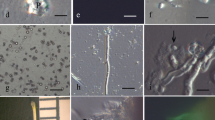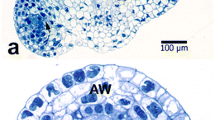Summary
Methods are described for the isolation of large quantities of generative cells and their protoplasts from the pollen ofLilium longiflorum. First, large numbers of pollen protoplasts were enzymatically isolated from immature pollen grains. When they were gently disrupted mechanically, the pollen contents including spindle-shaped generative cells were released. The generative cells were separated from other structures by Percoll density gradient centrifugation. They were nearly spherical, but had a callosic cell wall. The isolated generative cells were then re-treated in enzyme solution to yield authentic protoplasts. The generative cell protoplasts, “gametoplasts”, were uniform in size and contained a condensed haploid nucleus with relatively little cytoplasm.
Similar content being viewed by others
References
Angold RE (1968) The formation of the generative cell in the pollen grain ofEndymion non-scriptus (L). J Cell Sci 3: 573–578
Bajaj YPS (1974) Isolation and culture studies on pollen tetrad and pollen mother-cell protoplasts. Plant Sci Lett 3: 93–99
—,Davey MR (1974) The isolation and ultrastructure of pollen protoplasts. In:Linskens HF (ed) Fertilization in higher plants. Elsevier, Amsterdam, pp 73–80
Bhojwani SS, Cocking EC (1972) Isolation of protoplasts from pollen tetrads. Nature, New Biol 239: 29–30
Cass DD (1973) An ultrastructural and Nomarski-interference study of the sperms of barley. Can J Bot 51: 601–605
Dumas C, Knox RB, Gaude T (1985) The spatial association of the sperm cells and vegetative nucleus in the pollen grain ofBrassica. Protoplasma 124: 168–174
Heslop-Harrison J (1968) Synchronous pollen mitosis and the formation of the generative cell in massulate orchids. I Cell Sci 3: 457–466
—,Heslop-Harrison Y, Shivanna KR (1984) The evaluation of pollen quality and a further appraisal of the fluorochromatic (FCR) test procedure. Theor Appl Genet 67: 367–375
LaFountain KL, Mascarenhas JP (1972) Isolation of vegetative and generative nuclei from pollen tubes. Exp Cell Res 73: 233–236
Matthys-Rochon E, Vergne P, Detchepare S, Dumas C (1987) Male germ unit isolation from three tricellular pollen species:Brassica oleracea, Zea mays, andTriticum aestivum. Plant Physiol83: 464–466
McConchie CA, Jobson S, Knox PB (1985) Computer-assisted reconstruction of the male germ unit in pollen ofBrassica campestris. Protoplasma 127: 57–63
Nakamura S, Miki-Hirosige H (1985) Fine-structural study on the formation of the generative cell wall and intine-3 layer in a growing pollen grain of Lilium longiflorum. Am J Bot 72: 365–375
Pipkin JL, Larson DA (1973) Changing patterns of nucleic acids, basic and acidic proteins in generative and vegetative nuclei during pollen germination and pollen tube growth inHippeastrum belladonna. Exp Cell Res 79: 28–42
Pirrie A, Power JB (1986) The production of fertile, triploid somatic hybrid plants (Nicotiana glutinosa (n)+N.tabacum (2n)) via gametic: somatic protoplast fusion. Theor Appl Genet 72: 48–52
Russell SD (1986) Isolation of sperm cells from the pollen ofPlumbago zeylanica. Plant Physiol 81: 317–319
—,Cass DD (1981) Ultrastructure of the sperms ofPlumbago zeylanica 1. Cytology and association with the vegetative nucleus. Protoplasma 107: 85–107
Sanger JM, Jackson WT (1971a) Fine structure study of pollen development inHaemanthus katherinae Baker I. Formation of vegetative and generative cells. I Cell Sci 8: 289–301
— — (1971b) Fine structure study of pollen development inHaemanthus katherinae Baker II. Microtubules and elongation of the generative cells. J Cell Sci 8: 303–315
Tanaka I, Ito M (1980) Induction of typical cell division in isolated microspores ofLilium longiflorum andTulipa gesneriana. Plant Sci Lett 17: 279–285
— — (1981) Control of division patterns in explanted microspores ofTulipa gesneriana. Protoplasma 108: 329–340
—,Kitazume C, Ito M (1987) The isolation and culture of lily pollen protoplasts. Plant Sci 50: 205–211
—,Taguchi T, Ito M (1979) Studies on microspore development in liliaceous plants I. The duration of the cell cycle and developmental aspects in lily microspores. Bot Mag Tokyo 92: 291–298
Theunis CH, McConchie CA, Knox RB (1985) Three-dimensional reconstruction of the generative cell and its wall connection in mature bicellular pollen ofRhododendron. Micron and Microscopica Acta 16: 225–231
Wever GH, Takats ST (1971) Isolation and separation of s-competent and s-incompetent nuclei fromTradescantia pollen grains. Exp Cell Res 69: 29–32
White PR (1963) The cultivation of animal and plant cells, 2nd Ed. Ronald Press, New York, p 60
Author information
Authors and Affiliations
Rights and permissions
About this article
Cite this article
Tanaka, I. Isolation of generative cells and their protoplasts from pollen ofLilium longiflorum . Protoplasma 142, 68–73 (1988). https://doi.org/10.1007/BF01273227
Received:
Accepted:
Issue Date:
DOI: https://doi.org/10.1007/BF01273227




